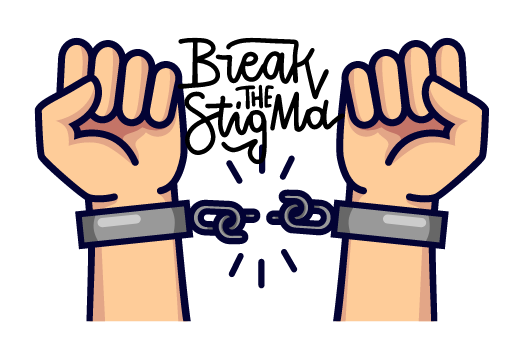May is Mental Health Awareness Month, a dedicated time to break the silence on mental health and combat the profound stigma that often accompanies it. It’s a pivotal opportunity to emphasize that mental health struggles continue throughout the year, not just during this month. Mental health touches us all in some way—either through our own experiences or those of someone close to us. By openly discussing mental health, we can dismantle the stigma and remove barriers to seeking treatment and support.
Understanding Mental Health and Illness
While the terms “mental health” and “mental illness” are sometimes used interchangeably, they refer to different aspects of psychological well-being. We all have mental health that we must maintain, just like our physical health. Mental illness, however, refers specifically to diagnosable conditions that cause emotional distress and can impact daily functioning.
My Connection to Mental Health
For most of my life, mental health has been more than just a term; it’s been a significant part of my identity. I’ve navigated through feelings of inadequacy, anxiety, depression, and a disordered relationship with food and exercise. At times, these challenges felt unbearable, making it seem impossible to adequately care for myself and maintain my well-being.
The Weight of Mental Illness
Though I’ve never received any formal diagnoses, I am intimately familiar with the crippling weight of mental illness. The National Institute of Health (NIH) describes mental disorders as conditions that affect a person’s thinking, feeling, mood, or behavior. Mental illness affects everyone differently, and symptoms can range from mild to severe.
The DSM, or the Diagnostic and Statistical Manual of Mental Disorders, is the book that professionals use to diagnose mental health conditions, or psychological disorders. It includes definitions and diagnostic criteria for hundreds of disorders, including depression, anxiety, eating disorders, trauma, and schizophrenia, to name a few.
Sadly, society often associates people with mental health conditions—especially those that suffer from severe symptoms—as “crazy,” “weak,” or “attention-seeking.” Not only are these labels harmful, but they are also false. Having a mental illness is not a choice. Society’s uneducated assumptions and false perceptions perpetuate the stigma surrounding mental health.
Navigating Silence and Stigma
As someone who has faced mental health challenges, I understand firsthand the profound impact of stigma. BetterHealth defines stigma as the negative attitudes or perceptions toward individuals with mental health conditions. This stigma goes beyond the external factors; it seeps into our psyche, creating internal barriers that feel impossible to overcome.
For me, stigma feels like being trapped in a suffocating cage, where I’m isolated from the understanding and support I desperately need. I often question my own suffering and berate myself for being unable to “just get over it.” My harsh inner critic taunts me repeatedly: “Why can’t you just be normal?”
Throughout my life, I’ve often felt like an outsider—misunderstood and lacking a true sense of belonging. This has intensified feelings of loneliness and despair, plunging me further into the shadows of my own mind. Additionally, the fear of being labeled or further misunderstood has left me navigating the darkness alone, despite the desperate longing for support.
My own battles with mental health highlight the pervasive impact of stigma in our lives. It’s a deeply personal struggle—the silent suffering, the invisible battles fought behind closed doors, and the relentless struggle to break free from the chains of judgment and shame.

Mental Health Statistics
Statistics (2021) from the National Institute of Mental Health illuminate the prevalence of mental health issues and the stigma that surrounds them:
- Approximately 20% (or 1 in 5) of U.S. adults live with a mental illness.
- About 57.8 million, or 23%, of the U.S. adult population suffered from any mental illness.
- Serious mental illness affected 14.1 million, or 5.5%, of the U.S. adult population.
- Suicide ranked as the 2nd leading cause of death for ages 10-14 and 25-34, the 3rd leading cause of death for ages 15-25, and the 11th leading cause of death for all ages.
Barriers to Treatment
Despite the high prevalence of mental health issues, many of us are unable to access the care we need due to various barriers. Some of these include:
- Stigma: Societal judgment and internalized shame often deter us from seeking the help we need. This perpetuates a cycle of silence and suffering.
- Cost and insurance: According to the National Council, 42% of us view high treatment costs and inadequate insurance coverage as major obstacles to accessing mental health care.
- Lack of access: For many of us, especially those in lower-income households or without insurance, mental health treatment remains out of reach.
- Diagnostic barriers and limitations: The DSM’s constantly evolving diagnostic criteria and “levels of severity” can make us feel invalidated if we don’t check every diagnostic box. As a result, we may hesitate to seek support. Additionally, insurance companies often require an official diagnosis before providing coverage, further complicating access to treatment. Moreover, they can exclude certain diagnoses or limit coverage based on their own criteria for what they deem as “medically necessary.” These perceptions of “severe” and “necessary” are dismissive, as our struggles cannot be measured or placed neatly into boxes. Only we know the true depth of our suffering.
- Lack of awareness and education: Both externally and internally, we lack awareness and proper education about mental health. While schools often emphasize physical fitness, i.e., gym class and athletics, they often overlook mental wellness. This imbalance further contributes to stigma and limits open discussions about mental health. As a result, many of us battling mental health challenges are left to suffer alone, and we may not even recognize or acknowledge our struggles.
Breaking Down Barriers & Raising Awareness
Breaking down barriers to mental health support is not just a societal responsibility, but also a deeply personal one. Many of us have felt the isolating effects of stigma firsthand, as if we’re trapped within invisible walls that separate us from the help and healing we desperately need. Often, it seems easier to suffer in silence than to seek help. We become burdened by the fear of being a burden to others. However, it’s vital to recognize that we cannot carry the weight of our suffering alone.
Through connections and shared stories, we can raise awareness, champion change, and be there for each other during our darkest times. Brick by brick, we can tear down the barriers to mental health support and create a more compassionate and inclusive society for all.
Getting and Offering Support
Navigating mental health challenges can feel like an uphill battle, but you are not alone. If you are struggling, you can receive support through a variety of resources. From reputable organizations and support groups to trusted individuals in your life, someone is willing to lend an ear.
If you know someone who is struggling, you can offer support by:
- Listening attentively: Take the time to listen without judgment. Simply being there can help them feel less alone.
- Encouraging professional help: Often, when someone is struggling with a mental illness, they may be reluctant to seek help. While it’s important to offer your support, expert intervention may be necessary. Encourage them to speak with a therapist or counselor who can provide the tailored care they need.
- Helping with daily tasks: Sometimes, when someone is struggling with their mental health, something as simple as making their bed can feel daunting. Offer to assist them with daily tasks that may seem overwhelming during difficult times. This could be running errands, preparing meals, or helping with household chores.
- Keeping regular contact: If you know someone who has gotten distant or quieter, check up on them regularly. A simple call, text, or visit can reassure them that you care and that they are not alone.
- Educating yourself and others: Knowledge is a powerful tool in breaking stigma and fostering understanding. Use free resources to educate yourself about mental health conditions and advocate for others to do the same.
Breaking the Silence: Continuing the Conversation Beyond May
While Mental Health Awareness Month serves as a catalyst for mental health discussions, it’s essential that we maintain this momentum year-round. By educating ourselves and empathizing with others, we can normalize conversations about mental health and combat stigma. Our shared struggles with mental health are what make us human—our emotions and feelings are the threads that connect us.
Whether you are navigating your own challenges or supporting someone who is, we must break the silence surrounding mental health. Behind glimmering eyes or a beaming smile may lie a story that yearns to be heard.
So, let’s keep the conversations alive. By embracing our shared humanity, we can illuminate the path forward and guide each other out of the shadows of silence and shame and into the light of hope and understanding.




Simplywall I like the efforts you have put in this, regards for all the great content.
Thank you so much!